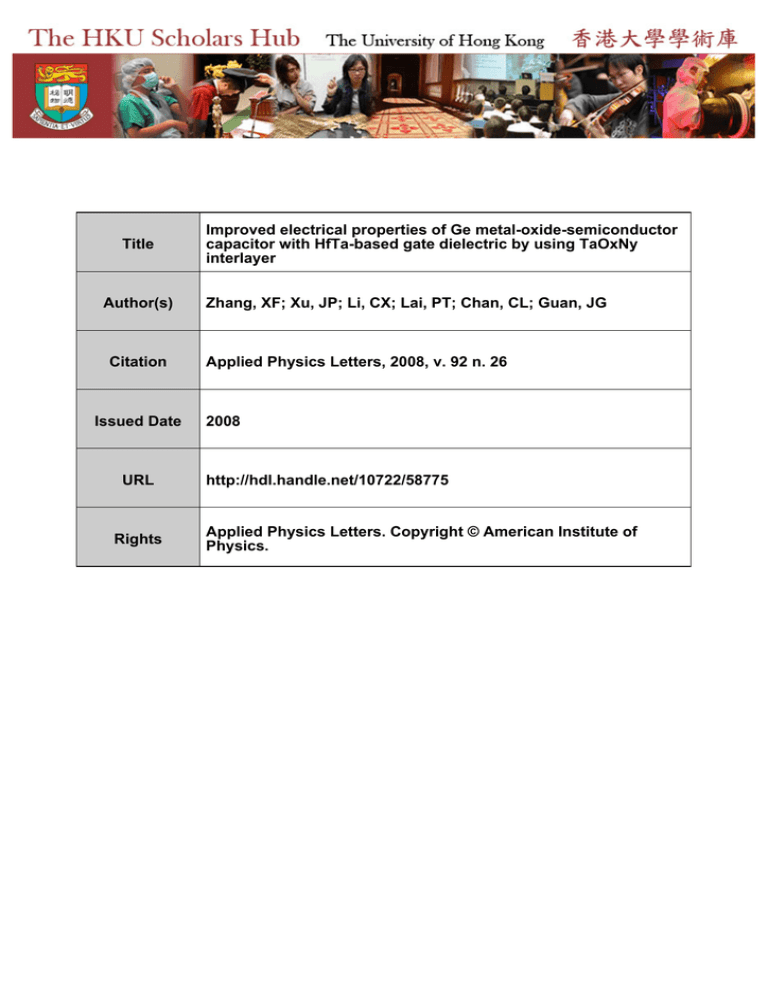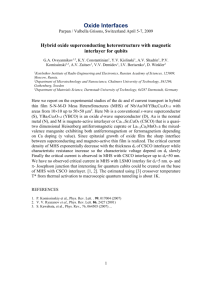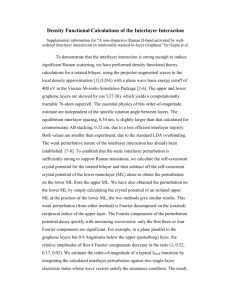Title Improved electrical properties of Ge metal-oxide
advertisement

Title Author(s) Citation Issued Date URL Rights Improved electrical properties of Ge metal-oxide-semiconductor capacitor with HfTa-based gate dielectric by using TaOxNy interlayer Zhang, XF; Xu, JP; Li, CX; Lai, PT; Chan, CL; Guan, JG Applied Physics Letters, 2008, v. 92 n. 26 2008 http://hdl.handle.net/10722/58775 Applied Physics Letters. Copyright © American Institute of Physics. APPLIED PHYSICS LETTERS 92, 262902 共2008兲 Improved electrical properties of Ge metal-oxide-semiconductor capacitor with HfTa-based gate dielectric by using TaOxNy interlayer X. F. Zhang,1 J. P. Xu,1,a兲 C. X. Li,2 P. T. Lai,2,a兲 C. L. Chan,2 and J. G. Guan3 1 Department of Electronic Science and Technology, Huazhong University of Science and Technology, Wuhan 430074, People’s Republic of China 2 Department of Electrical & Electronic Engineering, The University of Hong Kong, Pokfulam Road, Hong Kong, People’s Republic of China 3 State Key Laboratory of Advanced Technology for Materials Synthesis and Processing, Wuhan University of Science and Technology, Wuhan 430070, People’s Republic of China 共Received 2 April 2008; accepted 11 June 2008; published online 2 July 2008兲 HfTa-based oxide and oxynitride with or without TaOxNy interlayer are fabricated on Ge substrate to form metal-oxide-semiconductor 共MOS兲 capacitors. Their electrical properties and reliabilities are measured and compared. The results show that the MOS capacitor with a gate stack of HfTa-based oxynitride and thin TaOxNy interlayer exhibits low interface-state/oxide-charge densities, low gate leakage, small hysteresis, small capacitance equivalent thickness 共⬃0.94 nm兲, and high dielectric constant 共⬃24兲. All these should be attributed to the blocking role of the TaOxNy interlayer against penetration of O into the Ge substrate and interdiffusions of Hf, Ge, and Ta, thus effectively suppressing the formation of unstable low-k GeOx and giving a superior TaOxNy / Ge interface. Moreover, incorporation of N into both the interlayer and high-k dielectric greatly improves device reliability through the formation of strong N-related bonds. © 2008 American Institute of Physics. 关DOI: 10.1063/1.2954012兴 With the continuous scaling down of the dimensions of metal-oxide-semiconductor field-effect transistor 共MOSFET兲, silicon is approaching its fundamental scaling limits. Germanium is an alternative candidate for future channel material because of its high carrier mobility.1–3 However, unlike Si oxide, the thermodynamically unstable and soluble Ge oxide hinders the development of high-quality Ge MOSFET. Recently, Ge-based MOS capacitors and transistors with high-permittivity 共high-k兲 stacked gate dielectrics using a thin germanium oxynitride 共GeOxNy兲 interlayer have shown superior electrical properties.4–6 It has been shown that the GeOxNy interlayer provides a stable and smooth interface with improved electrical properties. However, its lower k value limits the scalability of Ge MOS devices, even as an interlayer. More recently, Lu et al.7 reported that an ultrathin tantalum nitride film deposited between high-k dielectric and Si substrate could suppress the formation of the SiOx interlayer during subsequent high-temperature annealing. This is because tantalum nitride can function as a diffusion barrier and can be oxidized to form nonconductive TaOxNy after annealing in O2. Moreover, Sugawara et al.8 demonstrated that a thin plasma-synthesized TaON interlayer on Ge could reduce stress-induced flatband-voltage shift. Since TaOxNy has a high k value 共⬃26兲 and high thermal stability,9 it should also be a promising candidate as the interlayer between high-k dielectric and Ge substrate. In this work, a thin TaNx layer is deposited by reactive sputtering prior to HfTa-based oxide or oxynitride deposition. The thin TaNx is used to suppress the formation of inferior GeOx and interdiffusions of relevant elements during the annealing of the deposited high-k dielectric, and at the same time TaNx itself is converted to TaOxNy during the annealing. Ta is a兲 Authors to whom correspondence should be addressed. Electronic addresses: jpxu@mail.hust.edu.cn and laip@eee.hku.hk. intentionally added to improve the crystallization temperature and dielectric constant of Hf-based oxide and oxynitride.10 As a result, excellent electrical properties such as low interface-state density, low gate leakage, and high reliability are obtained for the Ge MOS capacitors with HfTaON / TaOxNy and HfTaO / TaOxNy gate stacks. N-type 共100兲 Ge wafers with a resistivity of 0.040– 0.047 ⍀ cm were cleaned in organic solvents and rinsed in de-ionized water followed by a 30 s diluted HF 共1:50兲 dipping for several cycles to remove the native oxide 共GeOx兲. After drying in N2, the wafers were immediately transferred into Denton Vacuum Discovery Deposition System. First, a ⬃1 nm TaNx interlayer was deposited by reactive sputtering of Ta in an Ar+ N2 ambient 共Ar: N2 = 12: 18兲, followed by the deposition of a 5 nm HfTaO or HfTaN by cosputtering of Ta and Hf in an Ar+ O2 共Ar: O2 = 24: 3兲 or Ar+ N2 共Ar: N2 = 24: 6, a smaller ratio used to incorporate more nitrogen in the dielectric兲 ambient, respectively 共denoted as HfTaO / TaON or HfTaON / TaON sample兲. For comparison, a 6 nm HfTa or HfTaN was directly deposited on the cleaned Ge substrate without the TaNx interlayer as control samples 共denoted as HfTaO or HfTaON sample兲. A postdeposition annealing was carried out in wet N2 共500 ml/ min兲 at 500 ° C for 5 min to transform the films into oxides or oxynitrides 共i.e., HfTaO, HfTaON, and TaOxNy兲 by using the oxygen in water vapor.11 The wet-N2 atmosphere was realized by bubbling pure N2 through de-ionized water at 95 ° C with a flow rate of 500 ml/ min. Subsequently, Al was evaporated and patterned by lithography as gate electrodes with an area of 7.85⫻ 10−5 cm−2. Finally, forming-gas annealing was performed at 280 ° C for 20 min. Physical thicknesses of the gate dielectrics for the samples were determined by a multiwavelength ellipsometer. All electrical measurements were carried out under a light-tight and electrically shielded condition using HP4284A precision LCR 0003-6951/2008/92共26兲/262902/3/$23.00 92, 262902-1 © 2008 American Institute of Physics Downloaded 11 Feb 2011 to 147.8.21.150. Redistribution subject to AIP license or copyright; see http://apl.aip.org/about/rights_and_permissions 262902-2 Appl. Phys. Lett. 92, 262902 共2008兲 Zhang et al. FIG. 2. Hysteresis, interface-state density and equivalent oxide-charge density extracted from the HF C-V curves of the Ge MOS capacitors. FIG. 1. Typical high-frequency C-V curves of the Ge MOS capacitors under dark condition at room temperature, swept in both directions at a frequency of 1 MHz. Inset is gate leakage current density of the samples. meter and HP4156A precision semiconductor parameter analyzer. Typical HF 共1 MHz兲 C-V curves of the samples, swept in bidirections at 1 MHz, are shown in Fig. 1. The oxide capacitance 共Cox兲 obtained by correcting for frequency dispersion from maximum accumulation capacitance,12 physical thickness 共tphys兲, capacitance effective thickness 共CET兲 and equivalent k value 共=Coxtphys / 0A兲 for all the samples are extracted and listed in Table I. An obvious distortion is observed in the region from depletion to inversion of the C-V curves for the two samples without the TaOxNy interlayer, especially for the HfTaO sample, but does not exist for the two samples with a thin TaOxNy interlayer. This should be associated with significant interfacial defects originated from the interdiffusion between the gate dielectric and substrate, and the growth of a low-k GeOx interlayer, especially for the HfTaO sample. Therefore, it can be concluded that the TaOxNy interlayer can effectively block the oxidation of Ge surface and thus suppress the formation of unstable GeOx. Another fact is that Cox of the oxynitrides is larger than that of their oxide counterparts, indicating that larger k values have been obtained for the oxynitrides than the oxides for almost the same physical thickness, with the largest k value 共⬃24兲 and the smallest CET 共⬃0.94 nm兲 for the TaHfON / TaOxNy sample. Furthermore, the C-V hysteresis, the equivalent oxide-charge density 关Qox = −Cox共Vfb − ms兲 / q, where the work-function difference ms between Al gate and n-Ge substrate is calculated to be 0.0706 V兴 and the interface-state density near midgap 共Dit兲 estimated from the HF C-V curve by the Terman’s method13 are depicted in Fig. 2. As compared to the control samples, Dit is obviously reduced by inserting a thin TaOxNy interlayer between the TABLE I. Physical parameters extracted from the HF C-V curves of the Ge MOS capacitors. Sample Cox 共pF兲 tphys 共nm兲 CET 共nm兲 Equivalent k HfTaO / TaOxNy HfTaON / TaOxNy HfTaO HfTaON 253 289 201 240 5.86 5.83 5.96 6.06 1.07 0.94 1.35 1.13 21.4 24.2 17.2 20.9 high-k gate dielectrics and Ge substrate, especially for the HfTaON / TaOxNy sample. Moreover, the hysteresis and Qox are less for the two samples with the TaOxNy interlayer than the control samples, with HfTaON / TaOxNy sample being the smallest. The negative Qox might arises from OH−, which is related to the wet-annealing ambient,14,15 the acceptorlike interface states and electron traps in the oxide since the oxide charge density calculated from flatband voltage is a net effect of all charges in the oxide and at the interface. The smaller Qox of HfTaO / TaON and HfTaON / TaON samples should be partly attributed to their smaller Dit 共hence, less acceptorlike interface-state charges兲, as shown in Fig. 2. Further examination of the data in Fig. 2 implies the HfTaO / TaON and HfTaON / TaON samples having more positive charges than the samples without the TaON interlayer because their Qox reduction is only a portion of their Dit reduction. These additional positive charges could be introduced due to the HfTaO / TaON and HfTaON / TaON interfaces. The inset of Fig. 1 shows the gate-leakage properties of the samples. The two samples with the TaOxNy interlayer have lower leakage current than their control samples. Moreover, the oxynitride samples have lower leakage current than their oxide counterparts, with the HfTaON / TaOxNy sample being the lowest and HfTaO sample being the highest 共3.3⫻ 10−3 and 8.9⫻ 10−2 A cm−2 at Vg = Vfb + 1 V, respectively兲. It was reported that the incorporation of nitrogen into high-k dielectrics could reduce their leakage current by inhibiting species interdiffusion and changing the local coordination of high-k material, thus suppressing the onset of crystallization.16 So, the smaller leakage current for the oxynitride samples should be ascribed to the N incorporation. In fact, this is closely associated with the Dit and Qox of the samples shown in Fig. 2. A high-field stress at 10 MV/ cm 关=共Vg − Vfb兲 / tphys兴 for 3600 s, with the capacitors biased at accumulation, is used to examine the reliability of the samples. The leakage current density 共Jg兲 is measured for all the samples before and after the stress, as shown in Fig. 3. The Vfb shift after the stress is extracted from the HF C-V curves measured before and after the stress, as shown in the inset of Fig. 3. Increase of the leakage current and shift of flatband voltage after the stress are larger for the control samples than the samples with the TaOxNy interlayer because of an unstable GeOx layer grown at the interface of the former samples. Among all the samples, the HfTaON / TaOxNy sample exhibits the best reliability due to the formation of strong N-related bonds by Downloaded 11 Feb 2011 to 147.8.21.150. Redistribution subject to AIP license or copyright; see http://apl.aip.org/about/rights_and_permissions 262902-3 Appl. Phys. Lett. 92, 262902 共2008兲 Zhang et al. low leakage current. Therefore, the HfTaON / TaOxNy stack structure is a promising gate dielectric for making advanced small-sized Ge MOSFET with excellent electrical performances and high reliability. This work is financially supported by the National Natural Science Foundation of China 共Grant No. 60776016兲, Small Project Funding 共200707176147兲 of the University of Hong Kong, the University Development Fund 共Nanotechnology Research Institute, 00600009兲 of the University of Hong Kong, and Open Foundation of State Key Laboratory of Advanced Technology for Materials Synthesis and Processing 共Project No. WUT2006M02兲. 1 FIG. 3. Gate-leakage increase and flatband-voltage shift 共insrt兲 of the Ge MOS capacitors after a high-field stressing at 10 MV/ cm for 3600 s, with the samples biased at accumulation. significant incorporation of N into both the interlayer and high-k gate dielectric. Therefore, the thin TaOxNy interlayer can give excellent device performances due to its strong barrier role against diffusions of Hf, Ta, Ge, and O, and its good interface properties with the Ge substrate. Moreover, when the high-k dielectric layer is oxynitride, the electrical properties and reliability of the devices are further improved due to the formation of strong N-related bonds. The electrical properties and reliability of HfTa-based oxide and oxynitride with or without TaOxNy interlayer are investigated as the gate dielectric of Ge MOS capacitors. The thin TaOxNy interlayer can effectively block the interdiffusions of Ge, Hf, and Ta and also the penetration of oxygen into the Ge substrate, thus greatly suppressing the growth of unstable low-k GeOx during high-temperature annealing, and improving the interface quality and reliability of the devices. Low interface-state density and low leakage current have been achieved for the devices with HfTaON / TaOxNy or HfTaO / TaOxNy gate stack. Particularly, the sample with HfTaON / TaOxNy gate stack exhibits higher dielectric constant 共⬃24兲 and better high-field reliability than the other samples while keeping small CET 共⬃0.94 nm兲, Dit, Qox, and A. Ritenour, S. Yu, M. L. Lee, N. Lu, Wu. Bai, A. Pitera, E. A. Fitzgerald, D. L. Kwong, and D. A. Antoniadis, Tech. Dig. - Int. Electron Devices Meet. 2003, 18.2.1. 2 P. Zimmerman, G. Nicholas, B. De Jaeger, B. Kaczer, A. Stesmans, L.-A. Ragnarsson, D. P. Brunco, F. E. Leys, M. Caymax, G. Winderickx, K. Opsomer, M. Meuris, and M. M. Heyns, Tech. Dig. - Int. Electron Devices Meet. 2006, 655. 3 S. Joshi, C. Krug, D. Heh, H. J. Na, H. R. Harris, J. W. Oh, P. D. Kirsch, P. Majhi, B. H. Lee, H.-H. Tseng, R. Jammy, J. C. Lee, and S. K. Banerjee, IEEE Electron Device Lett. 28, 308 共2007兲. 4 C. O. Chui, H. Kim, D. Chi, P. C. McIntyre, and K. C. Saraswat, IEEE Trans. Electron Devices 53, 1509 共2006兲. 5 C. X. Li, P. T. Lai, and J. P. Xu, Microelectron. Eng. 84, 2340 共2007兲. 6 J. J. Chen, N. A. Bojarczuk, H. Shang, M. Copel, J. B. Hannon, J. Karasinski, E. Preisler, S. K. Banerjee, and S. Guha, IEEE Trans. Electron Devices 51, 1441 共2004兲. 7 J. Lu, Y. Kuo, J. Y. Tewg, B. Schueler, Vacuum 74, 539 共2004兲. 8 T. Sugawara, Y. Oshima, R. Sreenivasan, and P. C. Mclntyre, Appl. Phys. Lett. 90, 112912 共2007兲. 9 H. Jung, K. Im, H. Hwang, and D. Yang, Appl. Phys. Lett. 76, 3630 共2000兲. 10 X. Yu, C. Zhu, M. F. Li, A. Chin, A. Y. Du, W. D. Wang, and D. L. Kwong, Appl. Phys. Lett. 85, 2893 共2004兲. 11 K. Muraoka, in 13th IEEE International Conference on Advanced Thermal Processing of Semiconductors, 2005 共unpublished兲, p. 37. 12 K. J. Yang and C. Hu, IEEE Trans. Electron Devices 46, 1500 共1999兲. 13 E. H. Nicollian and J. R. Brews, MOS Physics and Technology 共Wiley, Hoboken, NJ, 1982兲, p. 325. 14 J. P. Xu, P. T. Lai, C. X. Li, X. Zou, and C. L. Chan, IEEE Electron Device Lett. 27, 439 共2006兲. 15 H. Yano, F. Katafuchi, T. Kimoto, and H. Matsunami, IEEE Trans. Electron Devices 46, 504 共1999兲. 16 P. S. Lysaght, J. Barnett, G. I. Bersuker, J. C. Woicik, D. A. Fischer, B. Foran, H. H. Tseng, and R. Jammy, J. Appl. Phys. 101, 024105 共2007兲. Downloaded 11 Feb 2011 to 147.8.21.150. Redistribution subject to AIP license or copyright; see http://apl.aip.org/about/rights_and_permissions

